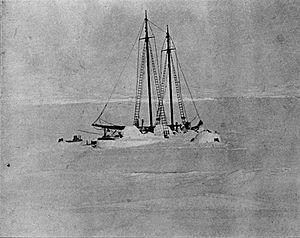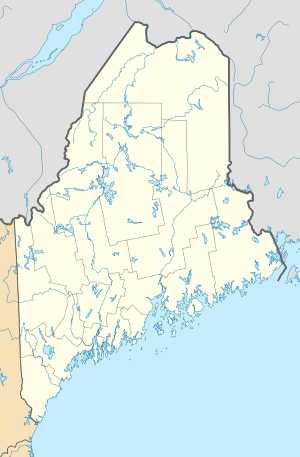Bowdoin (Arctic schooner) facts for kids
class="infobox " style="float: right; clear: right; width: 315px; border-spacing: 2px; text-align: left; font-size: 90%;"
|+Bowdoin
| colspan="2" style="text-align: center; font-size: 90%; line-height: 1.5em;" | 
|} The Bowdoin is a special kind of sailing ship called a schooner. It was built in 1921 in East Boothbay, Maine. A famous designer named William H. Hand, Jr. created its plans. The ship was built at the Hodgdon Brothers Shipyard.
What makes Bowdoin unique is that it's the only American schooner made just for exploring the Arctic. This cold, icy region is at the top of the world. The famous explorer Donald B. MacMillan helped design it. Bowdoin has traveled above the Arctic Circle 29 times! Since 1988, the Maine Maritime Academy has owned it. They use Bowdoin to train students how to sail. The ship is named after Bowdoin College.
Contents
History of the Bowdoin
Bowdoinfrozen in Arctic ice in 1923, with small igloo shelters built on the ice nearby.
The Bowdoin was built very carefully. Its design was strong and well-thought-out for its time. It was ready for tough Arctic conditions.
On August 23, 1921, Bowdoin sailed past the Arctic Circle for the first time. The Arctic was a mysterious place back then. Not many people had explored it. Just a few years before, explorers had finally found a way through the Northwest Passage. This was a sea route across the top of North America. However, it was too hard to use for regular travel.
Bowdoin went on many trips north with Donald MacMillan. It carried scientists, adventurers, and students. They studied the Arctic's unique environment.
Bowdoin in World War II
On May 22, 1941, the United States Navy bought Bowdoin. They needed ships for World War II. On June 16, 1941, it became a Navy ship called USS Bowdoin (IX-50). It was one of the few sailing ships used by the U.S. Navy during the war.
Its first captain was its former owner, Donald B. MacMillan. He was 66 years old but volunteered to serve. MacMillan was soon moved to another Navy job.
Bowdoin was sent to the South Greenland Patrol. This group helped defend Greenland. They also supported the United States Army in building air bases there. These bases were important stops for planes flying to Great Britain. Bowdoin helped survey and build these air bases. It served there for about 27 months.
In October 1941, the Greenland Patrols joined together. They reported directly to the Commander in Chief, Atlantic Fleet. On December 16, 1943, Bowdoin was taken out of Navy service. It was sold on January 24, 1945. Friends of MacMillan bought the ship. They fixed it up again for more Arctic adventures.
After the War: A New Life
In 1959, Admiral MacMillan sailed Bowdoin to Mystic Seaport in Mystic, Connecticut. He gave the ship to them for display. But the ship was not well cared for there. Its masts were even removed and broken.
In 1967, a group called the Schooner Bowdoin Association, Inc. was formed. They wanted to save the ship. Mystic Seaport gave Bowdoin to this group. Captain Jim Sharp then leased the ship. He worked hard to fix it up. In 1969, he sailed Bowdoin to MacMillan's home. The admiral, who was in his 90s, saw his beloved ship sail one last time.
Captain Sharp used Bowdoin as a museum and for charters. Later, new rules for passenger ships made it hard to keep its historic look. So, Bowdoin went back to the Association.
Between 1980 and 1984, Bowdoin had a big restoration. This work made the schooner like new again. The same shipyard that built it in 1921 helped with the repairs.
In 1986, Bowdoin became the official sailing vessel of Maine. In 1989, it was named a National Historic Landmark. This honor recognized its important role in Arctic exploration.
The restored Bowdoin sailed in OpSail '86. This was a big parade of ships in New York harbor. It celebrated the Statue of Liberty's restoration. In 1988, Bowdoin was given to the Maine Maritime Academy. They use it for sail training.
In 1990, Bowdoin sailed north again to Labrador. This was its first trip to the North since the 1950s. In 1991, it carried students to Disko Island, Greenland. This was 150 miles north of the Arctic Circle. It has continued to sail in Canadian waters. In 1994, it went 250 miles north of the Arctic Circle to Umanaq, Greenland. Its most recent Arctic voyage was in 2008.
In 2014, Bowdoin got a new mast. The old one was damaged. On August 15, 2014, Bowdoin sailed to Nova Scotia.
Awards and Honors
For its service during World War II, Bowdoin received several awards:
- American Defense Service Medal
- American Campaign Medal
- European-African-Middle Eastern Campaign Medal
- World War II Victory Medal
- This article incorporates text from the public domain Dictionary of American Naval Fighting Ships. The entry can be found here.
| History | |
|---|---|
| Owner |
|
| Builder |
|
| Launched | 1921 |
| Commissioned | 16 June 1941 as IX-50 |
| Decommissioned | 16 December 1943 |
| Stricken | 14 May 1944 |
| Identification |
|
| General characteristics | |
| Tonnage | 66 GRT |
| Length |
|
| Beam | 21 ft (6.4 m) |
| Draft | 10 ft (3.0 m) |
| Sail plan | Gaff-rigged Schooner |
|
Bowdoin (Arctic Exploration Schooner)
|
|
| Location | Castine, Maine |
| Built | 1921 |
| Architect | Hodgdon Brothers; William H. Hand, Jr. |
| NRHP reference No. | 80000411 |
| Significant dates | |
| Added to NRHP | 12 February 1980 |
| Designated NHL | 20 December 1989 |




